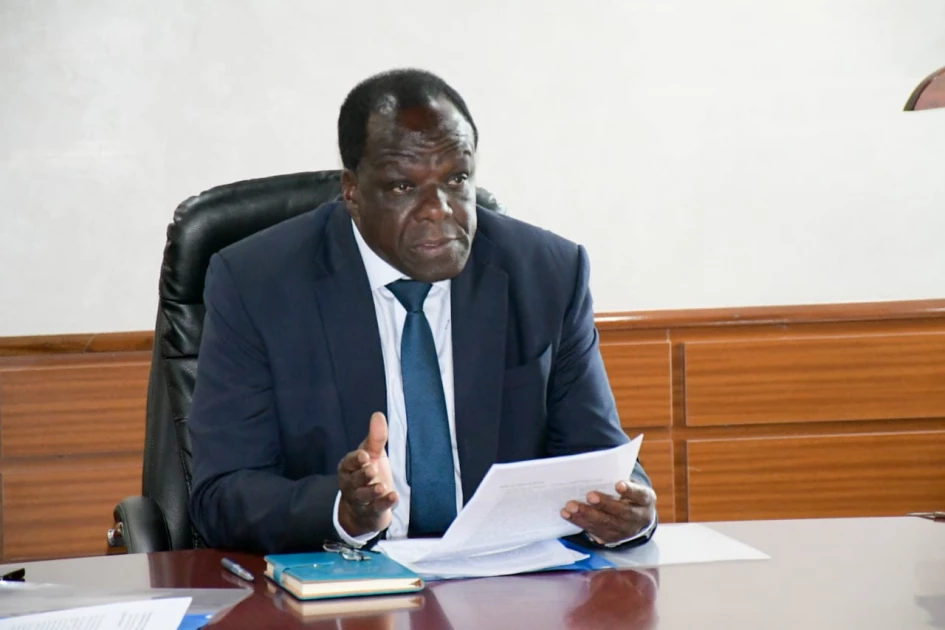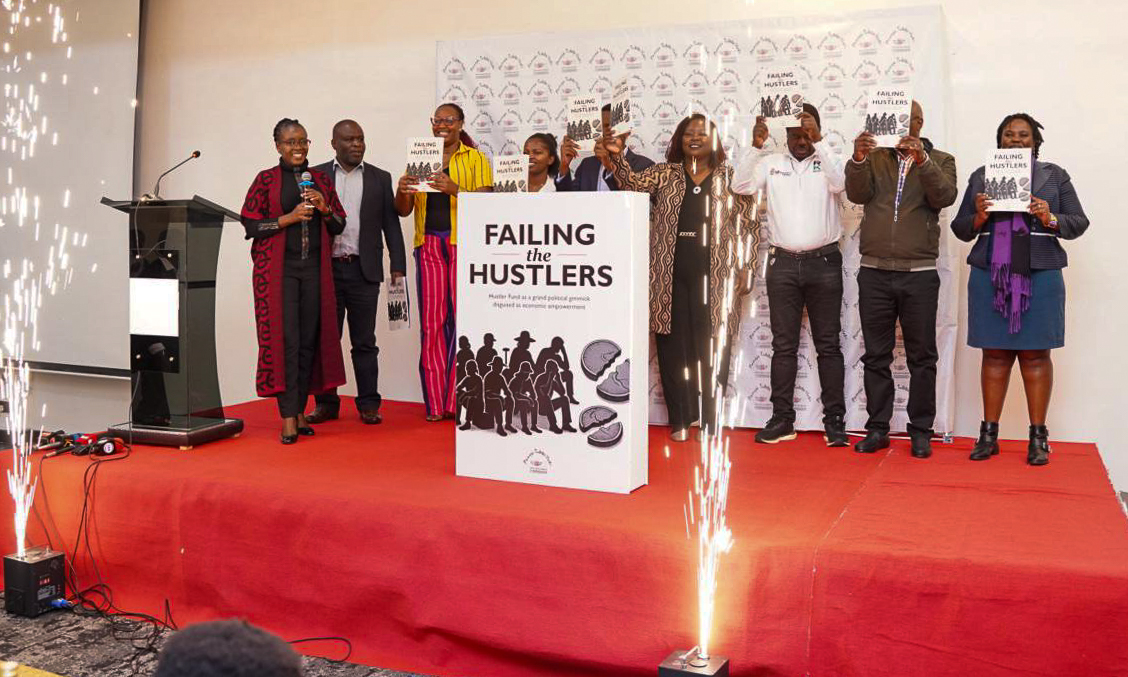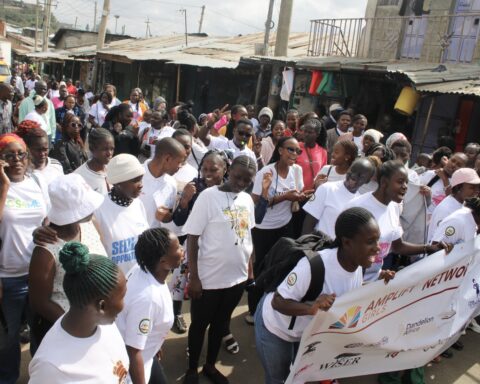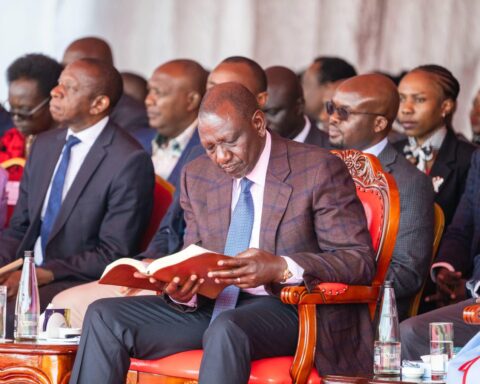KHRC report finds Hustler Fund failing, calls for shutdown
A new report by the Kenya Human Rights Commission has sharply criticized the Hustler Fund, describing it as a politically expedient but economically disastrous initiative that has failed to deliver on its promises of financial empowerment for low-income Kenyans.
The report, “Failing the Hustlers,” concludes that the Hustler Fund is structurally unsound, economically unsustainable, and politically manipulated, and recommends that the government scrap it entirely.
Launched in November 2022 with a startup capital of Sh50 billion, the Hustler Fund was marketed as a game-changer for the Kenya Kwanza regime’s “bottom-up” economic transformation agenda.
It promised to boost sectors such as agriculture, MSMEs, healthcare, housing, and the creative economy by offering accessible, affordable credit to millions of Kenyans locked out of the formal financial system.
However, the KHRC study found that this has not been achieved.
Quick money become dead money
By September 2024, over Sh53 billion had been disbursed. But the study found no measurable impact on enterprise development or job creation.
The loan amounts, ranging from just Sh500 to Sh1,000 for first-time borrowers, were too small to start or grow any meaningful business. Borrowers were given just 14 days to repay, a window KHRC deems unrealistic.
Worse still, the design of the Hustler Fund locks borrowers into a debt cycle.
A mandatory five percent deduction is made from each loan for savings before the money is disbursed, further reducing its utility. Borrowers must continue borrowing to qualify for slightly higher amounts, an unsustainable pattern that pushes low-income Kenyans deeper into financial distress.
Huster Fund’s performance metrics are equally poor.
By the end of 2022, the default rate stood at 68.3 percent. KHRC calculates that for every Sh500 disbursed, Sh340 is effectively lost. When added to the average Treasury bill rate of 8.2 percent (as of December 2022) and the three percent operational cost prescribed by law, the total estimated cost to the taxpayer reaches 71.5 percent.
“This is not financial empowerment. It is a loss-making scheme disguised as progress,” the KHRC said in the report. “Quick money has become dead money.”
KHRC also flagged governance failures.
The Office of the Auditor General could not conduct a full audit due to missing documentation and unsupported transactions.
The Fund was also launched without an oversight board, violating the law. Only after litigation did the government move to appoint one. Transparency around loan allocation criteria, regional disbursement data, and performance tracking remains missing.
KHRC contends that the Hustler Fund has become more of a political tool than a financial solution as it was rolled out after elections to fulfill campaign promises rather than to address fundamental economic needs.
“There is a growing perception that the Fund is a political reward for voting, and therefore repayment is optional,” the report warns. “This perception threatens the Fund’s credibility and undermines public accountability.”
Attempts to reform the Fund, KHRC says, would be futile. Technical tweaks cannot fix its design, political, and legal flaws.
“The evidence leads to a singular and inescapable conclusion that the Hustler Fund has failed and should be scrapped,” the report states.
2.0 METHODOLOGY
This section presents the methodology that was used in achieving the objectives of the study, which are
as follows:
2.1 CONCEPTUAL FRAMEWORK FOR ANALYSIS
To achieve the set objectives, a financial inclusion framework for analysis was developed to understand
better the factors influencing financial inclusion, with a specific focus on the Hustler Fund. Consumers
of financial products and services often have specific demands and, when well-informed, can make sound
financial decisions. Income levels largely influence their choices, although societal norms and beliefs may
also shape the type of products and services they seek.
On the supply side, financial service providers design products to meet consumer needs and distribute
them through channels such as branch networks, agents, or digital platforms. However, these products may come at a cost, including fees, interest rates, and transaction charges, limiting accessibility for low-income users.
The interaction between financial service providers and consumers occurs within an enabling environment
that determines the level of access, usage, and quality of financial services. A supportive ecosystem can lead to increased incomes, greater resilience to economic shocks, sustained economic growth, and a reduction in poverty and inequality.
Brief Look at the of the KHRC “Failing the Hustlers” document from me as Layperson.
Let us start with the methodology provided above.
In general the methodology is supposed to inform people about what methods of data collection and analysis will be used in the whole research project to achieve its objectives. Primarily that should include first and foremost the objectives of the research project itself as well as the intended objectives of the Hustler Fund when it was established so that the researchers can conclude whether the fund is achieving its goals or not.
Second, it should provide us with the primary information providers which in this case would be a credible representation of the entire number of Hustler Fund recipients preferably from diverse areas and economic sectors in the country to be interviewed so as to provide raw data and information which is the primary input of the research project and subsequent report. This is primarily to avoid situations where researchers provide the readers with random summaries not based on recorded data and information.
The objectives can also include the expectations from the public in terms of what the Hustler Fund would do to help them improve their businesses and their income as well as economic development. The research may also look at the prevailing economic conditions in the country as well as the business and economic environment that could be supportive to the Hustler Fund loans borrowers.
How can those conditions can be improved to make things better for the borrowers. This could be basic economic infrastructure like the market places where the those who get the loans do their business. Is there enough support to make the borrowers succeed.
Then we we have the Hustler Fund providers and administrative infrastructure workers to be interviewed who will provide data and information from their side and other parties of interest to help evaluate what the Hustler Fund has achieved or failed to achieve.
The most shocking thing here after reading the report in the Hustler Fund research is that it provides absolutely no information about what the research project is supposed to achieve.
Under introduction which is supposed to tell us how the research was supposed to be done and its general and achievable expectations from the researchers you find politically loaded assumptions being stated as facts and that is before we even you get a chance to read the research itself and its findings.
Introduction To The Research Project.
Bellow are some of the key parts provided in the introduction to the project.
“The Hustler Fund was sold to the public as a tool to cushion informal sector players from financial shocks, offering so-called “holistic” solutions to improve livelihoods. It promised to expand access to credit for individuals, MSMEs, SACCOs, and startups to spur economic growth and job creation.
Products under the Fund include personal loans, group micro-enterprise loans, and individual micro-enterprise loans for formally registered businesses.
According to government-released data, the Hustler Fund has disbursed over Sh36 billion to 21
million individuals, with more than 51,000 groups registered, boasting a total group membership of over 1.1 million people.
Around Sh163 million has been disbursed to these groups. But behind these
statistics is the fact that the fund, like many state run financial inclusion programs, is a politically expedient project often rolled out after elections to fulfil campaign promises, not long-term solutions rooted in the lived realities of Kenyans. While timely access, affordability, and impact are supposedly the cornerstones of the Hustler Fund, the scheme is riddled with contradictions“
“Despite Kenya’s progress in expanding formal financial services, the structural design of financial inclusion funds like the Hustler Fund appears rigged. Far from empowering the poor, these initiatives increasingly serve a small elite of microlenders.
Their profit-first, people-last model is driven by short term gains and predatory practices, which only worsen the financial vulnerability of low-income groups. This flies in the face of constitutional principles of public finance, which demand that public funds be managed prudently and with special provisions for the marginalized”.
In what should be an introduction we find words like ” so called “holistic”; “funds politically expedient”: “fulfill campaign promises’; “not long term solutions”; “supposedly conerstones”.
“Hustler Fund appears”; “serve a small elite of microlenders“; “profit-first, people-last model”; “short term gains and predatory practices”
Those kinds of opinions should come from the results after the research has been done and verifiable facts and data to support such summations are provided not before otherwise the research project becomes a vain excise to be a coverup up for what some people doing the work have already concluded about the Hustler Fund.
In this case the introduction to the KHRC Hustler Fund project reads, looks and sounds like conclusions already made and sadly enough that is before the research itself was done because the introduction should tell all of us including the lenders who are the primary subject in this research what the project intends to achieve and how.
It is only after the research is done that conclusions are drawn from the findings through the research not what some people were thinking before the research was done.
I went through the whole document which is 44 pages so people should read through it easily, but I was specifically looking for any interviews and information obtained from those who have used Hustler Fund because they are the premise of the research and a key component of what the whole project is about.
The research is supposed to find out how the Hustler Fund is used and how it can be used better and to do that one needs an organized and systematic collection, summary and review of data and first hand information from those who have received money from Hustler Funds so as to enable the researchers to make credible conclusions and suggestions to correct inherent problems.
I finally found that information on page 35 of the report. I don’t know what to say about the data collection based on what I found there but it looks like a summary of random street interviews or phone calls someone did in one day just talking to people they meet here and there.
I have never seen or heard of any research study in which the primary subjects of the research project are given such a random and comical kind of interviews and the results provided as “stories”
Here is what is provided through contacts with Hustler Fund recipients and I find it hard to believe that this is how the alleged billions of Hustler Fund claimed by the government has been used.
NEGATIVE STORIES POSITIVE STORIES
“We are being given Sh300 or Sh500 in the name of Hustler Fund, what business can you start with such an amount?”
Hustler Fund beneficiary
“I found I was eligible to access Sh1,500, which, of course, I accessed and used to buy lunch. I paid it back later anyway.”
Private university student
“Only those with problems can take that money; I cannot, since I am struggling to get capital. I do not want to be arrested for defaulting on Sh400.”
“I cannot take the Hustler Fund because, as a vendor, City Council can come and confiscate my goods, and I will not be able to repay. Therefore, it is risky to take the loan as this business does not have a permanent structure.”
Nairobi business trader
“Even though the hustler fund was intended to help businesses, it has provided little benefit to mine. The amount available is insufficient to purchase stock for my shop; I can
only use it for emergencies.” Joyce Wanja, a first-time borrower of Sh500
POSITIVE STORIES
“When I first borrowed from the kitty, I got Sh500.
The amount accessible through my phone was Sh475, which wasn’t even enough to restock any of the items I sell. I had to pay back the money and borrow frequently to increase my limit.
Later, the fund raised my limit to Sh1,000. It may not seem like much, but it has proven useful at times when I need to restock a few items and cover my utility bills.
A mobile phone accessories shop operator
”At that time, it was very difficult for me to access affordable credit. So, when they unveiled the fund,
I decided to give it a try. My loan limit is Sh1,000, and it has truly helped me, as I was able to start this
business, which serves as a source of income for me.
A sausage vending businessman
“With the Hustler Fund, most operators can service their motorbikes and purchase small spare parts,
and after two weeks, they can repay this loan. We began as individuals and registered as a group with
MSEA, allowing us to access more funding individually.”
A boda boda chairman in Nairobi
“The Hustler Fund has helped me increase my stock of pawpaw by Sh500. I sold them and made a profit
of Sh500. With Sh1,000, I was able to restock more. I hope to start an M-Pesa business over time.
A vegetable vendor in the Kilimani area
Research summary on the information collected is provided below the table of “stories” and below is that summary from the researching team.
Most recipients used Hustler Fund loans for personal expenses rather than business purposes, partly explaining the widespread lack of urgency in repayment. Others remain cautious about borrowing due to the informal and unstable nature of their businesses, particularly those operating without permanent structures. The threat of demolition or confiscation of goods by county authorities, combined with the inability to afford licenses and other operational permits, is a significant deterrent to taking on debt.
The Kenya government according to CS Oparanya, claims they are disbursing Sh68 million daily through the fund, and a total of Sh72 billion has been issued to borrowers so far.
The interviews of Hustler Fund recipients above does not give any kind of information where that Sh. 68 million a day is going and where the whole sum of Sh.72 billion has gone which is the total amount the government claims they have spent. That to me that should have been the focus of any research on Hustler Fund and that cannot be obtained from random interviews with less than 20 people most of whom did not want the money for different reasons and a few who received minimum loans in each case.
What we are missing from the government and from the KHRC research based on the report they have produced which would guide the public into what to do next besides just calling for Hustler Fund to be abandoned, is where the Sh. 72 billion so far spent has gone because it is tax payers money. Neither the KHRC report nor mere statements from the government provides or even seem to want to provide that information.
If the government has spent Sh. 72 billion since the Hustle Fund was established and KHRC interviewed three people who received in total Sh. 2,500.00, the first question is what percentage is Sh. 2,500 out of Sh. 72 billion.
From the “stories” in page 35 of the KHRC document, other than the people who refused to take the loan there are only three people in the interviews who actually got the loan.
A vegetable vendor who got Sh. 500.00. A phone mobile operator who got 1,000.00. A sausage vendor who got 1,000.00. That is it for those who got loans from the KHRC list.
Is this really a fair and reasonable number of Hustler Fund receivers in the last two to three years? Can anyone make decisions and come to conclusions about the Hustler Fund operations from those who got loans based on those three people who got a total of Sh. 2,500.00 out of Sh. 72 billion loaned out or is the government just cooking up stories about how much money they have provided to lenders.
I personally don’t care much for the statement from Cooperatives and MSMEs Cabinet Secretary Wycliffe Oparanya because he is saying what Kenyans expect him to say, but from what I have read in the KHRC report they provide every reason from any Kenyan to dismiss the whole research because the report is loaded with political statements rather than any actual research findings.
My intention is to go through the whole document piece by piece and compare it to research project in Kenya in 1995 by Friedrich Ebert Stiftung (FES) in partnership with the People Against Torture (PAT) part of KHRC under the auspices of Citizens for Justice which produced the document “We Lived To Tell”
In that project every person that had gone through torture and imprisonment including families of those killed were given an opportunity to provide information about their experiences through very detailed interviews and the whole document is full to the brim with direct information from people who were the primary subject of the project and anybody who reads those interviews can make their own conclusions about what was happening.
There is another research project which I participated in here in Toronto through a focus group model of research and I am going to go through that too before I can come to any valuable conclusions about the “FAILING HUSTLERS” document published by KHRC.
One thing that would be important information from those who did the research is to provide the period covered by their work. Is it from 2022 – 2024? The period covered is important because then we know how much money we are talking about from the government.
Also it might be important to find out the amount of loans the recipients interviewed by the KHRC research team got from the government. We can have one group of those who received Sh. 300.00 to Sh. 2,000.00 in one category and find information from a reasonable number of those. Then take those who have received or are receiving Sh. 2,000.00 to Sh.10,000.00 and find out how they have made it to get such amounts and how that is working for them.
Then find out the maximum amount the Hustler Fund has provided to those getting loans or is providing at this time and interview investors in that category and let Kenyans see how they can make it to that level. It is important to find out if some people are getting larger amounts of start-up loans than others and how that is happening.
There are frequent times the KHRC report talks about Hustler Funds being politically motivated because the present government promised it during their campaigns. That is an issue for political parties if they want to do their own research on Hustler Funds. The focus for KHRC is to find out what is exactly happening.
If there is evidence that the loans are being provided to Kenyans with specific political alignments like being KK supporters and not to other people then we need that information to come from the data collected not through political statements from the researchers who maybe having their own agenda as far as Hustler Fund Project is concerned.
Essentially Kenyans reading the document need a little respect from the researchers so they can take the findings of the whole effort seriously and find it meaningful to them as people who actually are able to understand information and make their own conclusions. If that is lacking it undermines everything including the report itself.
Oparanya defends Hustler Fund against ‘politically-motivated’ KHRC report

Co-operatives and Micro, Small and Medium Enterprises (MSMEs) Development Cabinet Secretary Wycliffe Oparanya has defended the Hustler Fund against criticism from a Monday report by the Kenya Human Rights Commission (KHRC), dismissing it as “skewed, elitist and politically motivated.”
KHRC warned that the programme is a recipe for financial failure as it lacks a sustainable plan to empower Kenyans at the bottom of the pyramid, as earlier intended.
According to the rights body, scrapping the programme is the only viable option for the Kenyan government, as reforming or re-engineering the Fund will not address the fundamental design, political, and legal flaws that have haunted it since its inception in November 2022.
In response, Oparanya accused KHRC of using flawed data and biased methodology to discredit the Fund, which he said has made significant strides in expanding financial inclusion since its launch in late 2022.
“The title of the report explicitly betrays the whole purpose of the study,” Oparanya said in a statement, questioning why the ministry or the Fund’s management had not been consulted during the research process.
“Professionalism demands a response from key players. The conclusions made are keen to sentence the Fund to death without trial.”
The KHRC report criticised the Fund’s accessibility, loan limits, and sustainability; findings the CS said were based on premature data, including just the first month of operations.
Oparanya challenged several claims made in the report, including an assertion that the Fund was capitalized with Ksh.50 billion.
“The amount so far injected is Ksh.14 billion, which has been reinvested in a portfolio of over Ksh.72 billion,” he said.
He also dismissed allegations that the Fund is difficult to access, saying over 9 million people borrow regularly from the Hustler Fund, and over 5 million borrowers have demonstrated strong repayment behaviour, making them eligible for larger amounts under the “Bridge” loan product.
The CS described the KHRC report’s conclusions as “lazily drawn,” noting that the Fund has already begun transitioning successful borrowers into the formal banking system through partnerships with commercial banks.
Oparanya also cited a recent Central Bank of Kenya report that found the Hustler Fund had overtaken institutions like the Agricultural Finance Corporation in financing farmers at the grassroots.
“The NGO either doesn’t understand the credit market landscape or feigned ignorance to buttress their political motive,” Oparanya said.
He claimed the report’s initial planned release date (June 24th) was designed to coincide with the anniversary of the 2024 anti-Finance Bill protests, further evidence, he argued, of its political slant.
Oparanya concluded by urging the public to view the Hustler Fund as a transformative tool rather than through “a narrow and malicious political lens.”









